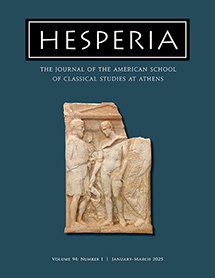Hesperia 94.1 Now Online!

We are pleased to announce the publication of Hesperia 94.1! Topics in this issue include an inscribed bronze strigil dedicated to Apollo at Despotiko, depictions of hares in funerary art memorializing young males in Archaic and Classical Athens, inscriptions found on athletic equipment including stone and metal jumping weights and discuses, and the purposeful placement of funerary monuments along routes connected to famous battle sites in Attica.
Subscribers can read the issue online at Project MUSE, which now hosts current issues of Hesperia as well as an archive of past volumes dating to 2002. Hesperia remains on JSTOR as part of their Arts and Sciences II package, with the usual three-year moving wall. Additionally, all issues of Hesperia from 2011 and earlier are available as Open Access on our website. The printed version will be mailed shortly.
A Twice-Inscribed Strigil from the Sanctuary of Apollo on Despotiko, by Manolis Petrakis, offers a contextual, typological, and epigraphical analysis of an inscribed Late Archaic strigil found during the 2016 excavations at the Sanctuary of Apollo on Despotiko in the Cyclades. The examination of the superimposed inscriptions permits a synthesis of the object’s biography, enabling us to identify the stages of “transformation” of a personal accessory into a votive offering. As a result, the strigil contributes to an understanding of dedicatory practices at the Despotiko sanctuary and their historical context.
Signifying Lost Potential: The Hare in the Funerary Art of Archaic and Classical Athens, by Katia Margariti, explores the iconography and function of the hare in Athenian funerary art of the Archaic and Classical periods. The animal appears on a limited number of vases and funerary reliefs decorated with scenes at the grave, images related to the hunt, or depictions of a deceased holding a pet hare. It is almost exclusively associated with male figures, especially of young age. This is due to the animal’s popularity as hunting prey and its highly sexual nature. A live hare in a funerary scene functions as a symbol of untimely death and lost potential for young males, emphasizing that they died before they could marry and produce children that would continue their family line.
Haptic Reading: Verse and Prose Inscriptions on Jumping Weights and Discuses, by Peter J. Miller, examines inscriptions in prose and verse on dedications of athletic equipment from pentathlon competitions, specifically jumping weights and discuses from the Archaic and Early Classical periods. By paying close attention to the layout of inscriptions and contextualizing these sorts of dedications in light of literary evocations of athletic objects, it is possible to argue that handling and moving an athletic dedication added significantly to the meaning and potency of the inscription.
Old Battles and New Funerary Monuments: Tombstones Along Sacred Routes in Classical Attica, by Matthew A. Sears, proposes that certain late 5th- and 4th-century BCE Attic funerary monuments were situated in such a way as to advertise a connection to a famous battlefield, even if the deceased had no personal connection to the relevant battle. Several monuments discovered outside of the deme named in their inscription stood on or near the plain of Marathon, along the renowned route between Marathon and Athens, or on the island of Salamis, while other monuments were set along sacred ways to sanctuaries such as those at Eleusis, Brauron, and Cape Zoster; this suggests a possible parallel between the routes to battlefields and sacred ways to sanctuaries. Accordingly, this article suggests a new avenue for the study of Attic funerary practices: namely, it elucidates a possible way in which the burial of the dead related to Athens’s military past and the sacred landscape.
Click here to subscribe to Hesperia. In addition to receiving printed issues and online access to Hesperia, subscribers also receive complimentary online access to Hesperia Supplements, and Agora and Corinth volumes.
Hesperia welcomes submissions from scholars working on all aspects of Greek material culture, including archaeology, art, architecture, history, epigraphy, and related studies. Further information about the journal, including instructions for preparing manuscripts for submission, can be found on our website.
The Friends of Hesperia was founded in 2014 to help fund the journal's growth in all its manifestations. We invite you to become a member today and help support one of the most preeminent journals in the field of Mediterranean archaeology.